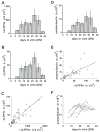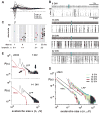Homeostasis of neuronal avalanches during postnatal cortex development in vitro
- PMID: 18082894
- PMCID: PMC2743406
- DOI: 10.1016/j.jneumeth.2007.10.021
Homeostasis of neuronal avalanches during postnatal cortex development in vitro
Abstract
Cortical networks in vivo and in vitro are spontaneously active in the absence of inputs, generating highly variable bursts of neuronal activity separated by up to seconds of quiescence. Previous measurements in adult rat cortex revealed an intriguing underlying organization of these dynamics, termed neuronal avalanches, which is indicative of a critical network state. Here we demonstrate that neuronal avalanches persist throughout development in cortical slice cultures from newborn rats. More specifically, we find that in spite of large variations of average rate in activity, spontaneous bursts occur with power-law distributed sizes (exponent -1.5) and a critical branching parameter close to 1. Our findings suggest that cortical networks homeostatically regulate a critical state during postnatal maturation.
Figures





Similar articles
-
Neuronal avalanches are diverse and precise activity patterns that are stable for many hours in cortical slice cultures.J Neurosci. 2004 Jun 2;24(22):5216-29. doi: 10.1523/JNEUROSCI.0540-04.2004. J Neurosci. 2004. PMID: 15175392 Free PMC article.
-
Statistical analyses support power law distributions found in neuronal avalanches.PLoS One. 2011;6(5):e19779. doi: 10.1371/journal.pone.0019779. Epub 2011 May 26. PLoS One. 2011. PMID: 21720544 Free PMC article.
-
Self-organization and neuronal avalanches in networks of dissociated cortical neurons.Neuroscience. 2008 Jun 2;153(4):1354-69. doi: 10.1016/j.neuroscience.2008.03.050. Epub 2008 Mar 29. Neuroscience. 2008. PMID: 18448256
-
Spindle Bursts in Neonatal Rat Cerebral Cortex.Neural Plast. 2016;2016:3467832. doi: 10.1155/2016/3467832. Epub 2016 Jan 13. Neural Plast. 2016. PMID: 27034844 Free PMC article. Review.
-
Compensatory physiological responses to chronic blockade of amino acid receptors during early development in spontaneously active organotypic cerebral cortex explants cultured in vitro.Prog Brain Res. 2005;147:231-48. doi: 10.1016/S0079-6123(04)47018-6. Prog Brain Res. 2005. PMID: 15581710 Review.
Cited by
-
Higher-order interactions characterized in cortical activity.J Neurosci. 2011 Nov 30;31(48):17514-26. doi: 10.1523/JNEUROSCI.3127-11.2011. J Neurosci. 2011. PMID: 22131413 Free PMC article.
-
Irregular spiking of pyramidal neurons organizes as scale-invariant neuronal avalanches in the awake state.Elife. 2015 Jul 7;4:e07224. doi: 10.7554/eLife.07224. Elife. 2015. PMID: 26151674 Free PMC article.
-
Spike avalanches in vivo suggest a driven, slightly subcritical brain state.Front Syst Neurosci. 2014 Jun 24;8:108. doi: 10.3389/fnsys.2014.00108. eCollection 2014. Front Syst Neurosci. 2014. PMID: 25009473 Free PMC article.
-
Coherence potentials: loss-less, all-or-none network events in the cortex.PLoS Biol. 2010 Jan 12;8(1):e1000278. doi: 10.1371/journal.pbio.1000278. PLoS Biol. 2010. PMID: 20084093 Free PMC article.
-
Early NMDA receptor-driven waves of activity in the developing neocortex: physiological or pathological network oscillations?J Physiol. 2010 Jan 1;588(Pt 1):83-91. doi: 10.1113/jphysiol.2009.178798. Epub 2009 Nov 16. J Physiol. 2010. PMID: 19917570 Free PMC article. Review.
References
-
- Abeles M. Corticonics. 1. Cambridge University Press; New York Port Chester Melbourne Sydney: 1992.
-
- Arieli A. Novel strategies to unravel mechanisms of cortical function: From macro- to micro-electrophysiological recordings. In: Aertsen A, Braitenberg V, editors. Information Processing in the Cortex. Springer-Verlag; Berlin: 1992. pp. 123–37.
-
- Bak P. How Nature Works: The Science of Self-Organized Criticality. Copernicus Books; New York: 1996.
-
- Bak P, Chen K, Paczuski M. Solitons in the one-dimensional forest fire model. Phys Rev Lett. 2001;86:2475–7. - PubMed
Publication types
MeSH terms
Grants and funding
LinkOut - more resources
Full Text Sources
Other Literature Sources

